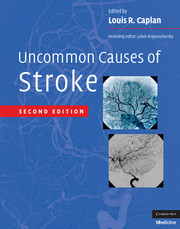Book contents
- Uncommon Causes of Stroke
- Uncommon Causes of Stroke
- Copyright page
- Contents
- List of Contributors
- Preface
- PART I: INFECTIOUS AND INFLAMMATORY CONDITIONS
- PART II: HEREDITARY AND GENETIC CONDITIONS AND MALFORMATIONS
- PART III: VASCULAR CONDITIONS OF THE EYES, EARS, AND BRAIN
- PART IV: DISORDERS INVOLVING ABNORMAL COAGULATION
- PART V: SYSTEMIC DISORDERS THAT ALSO INVOLVE THE CEREBROVASCULAR SYSTEM
- 43 MICROSCOPIC POLYANGIITIS AND POLYARTERITIS NODOSA
- 44 CHURG-STRAUSS SYNDROME
- 45 SYSTEMIC LUPUS ERYTHEMATOSUS
- 46 RHEUMATOID ARTHRITIS AND CEREBROVASCULAR DISEASE
- 47 HYPERVISCOSITY AND STROKE
- 48 CALCIUM, HYPERCALCEMIA, MAGNESIUM, AND BRAIN ISCHEMIA
- 49 STROKE AND SUBSTANCE ABUSE
- 50 CANCER AND PARANEOPLASTIC STROKES
- 51 KOHLMEIER-DEGOS’ DISEASE (MALIGNANT ATROPHIC PAPULOSIS)
- 52 STROKE IN PATIENTS WHO HAVE INFLAMMATORY BOWEL DISEASE
- 53 SWEET’S SYNDROME (ACUTE FEBRILE NEUTROPHILIC DERMATOSIS)
- 54 NEPHROTIC SYNDROME AND OTHER RENAL DISEASES AND STROKE
- 55 EPIDERMAL NEVUS SYNDROME
- 56 SNEDDON’S SYNDROME
- 57 MITOCHONDRIAL AND METABOLIC CAUSES OF STROKE
- 58 BONE DISORDERS AND CEREBROVASCULAR DISEASES
- 59 SCLERODERMA
- PART VI: NONINFLAMMATORY DISORDERS OF THE ARTERIAL WALL
- PART VII: VENOUS OCCLUSIVE CONDITIONS
- PART VIII: VASOSPASTIC CONDITIONS AND OTHER MISCELLANEOUS VASCULOPATHIES
- PART IX: OTHER MISCELLANEOUS CONDITIONS
- Index
59 - SCLERODERMA
from PART V: - SYSTEMIC DISORDERS THAT ALSO INVOLVE THE CEREBROVASCULAR SYSTEM
Published online by Cambridge University Press: 06 January 2010
- Uncommon Causes of Stroke
- Uncommon Causes of Stroke
- Copyright page
- Contents
- List of Contributors
- Preface
- PART I: INFECTIOUS AND INFLAMMATORY CONDITIONS
- PART II: HEREDITARY AND GENETIC CONDITIONS AND MALFORMATIONS
- PART III: VASCULAR CONDITIONS OF THE EYES, EARS, AND BRAIN
- PART IV: DISORDERS INVOLVING ABNORMAL COAGULATION
- PART V: SYSTEMIC DISORDERS THAT ALSO INVOLVE THE CEREBROVASCULAR SYSTEM
- 43 MICROSCOPIC POLYANGIITIS AND POLYARTERITIS NODOSA
- 44 CHURG-STRAUSS SYNDROME
- 45 SYSTEMIC LUPUS ERYTHEMATOSUS
- 46 RHEUMATOID ARTHRITIS AND CEREBROVASCULAR DISEASE
- 47 HYPERVISCOSITY AND STROKE
- 48 CALCIUM, HYPERCALCEMIA, MAGNESIUM, AND BRAIN ISCHEMIA
- 49 STROKE AND SUBSTANCE ABUSE
- 50 CANCER AND PARANEOPLASTIC STROKES
- 51 KOHLMEIER-DEGOS’ DISEASE (MALIGNANT ATROPHIC PAPULOSIS)
- 52 STROKE IN PATIENTS WHO HAVE INFLAMMATORY BOWEL DISEASE
- 53 SWEET’S SYNDROME (ACUTE FEBRILE NEUTROPHILIC DERMATOSIS)
- 54 NEPHROTIC SYNDROME AND OTHER RENAL DISEASES AND STROKE
- 55 EPIDERMAL NEVUS SYNDROME
- 56 SNEDDON’S SYNDROME
- 57 MITOCHONDRIAL AND METABOLIC CAUSES OF STROKE
- 58 BONE DISORDERS AND CEREBROVASCULAR DISEASES
- 59 SCLERODERMA
- PART VI: NONINFLAMMATORY DISORDERS OF THE ARTERIAL WALL
- PART VII: VENOUS OCCLUSIVE CONDITIONS
- PART VIII: VASOSPASTIC CONDITIONS AND OTHER MISCELLANEOUS VASCULOPATHIES
- PART IX: OTHER MISCELLANEOUS CONDITIONS
- Index
Summary
Keywords
- Type
- Chapter
- Information
- Uncommon Causes of Stroke , pp. 429 - 432Publisher: Cambridge University PressPrint publication year: 2008
- 1
- Cited by



